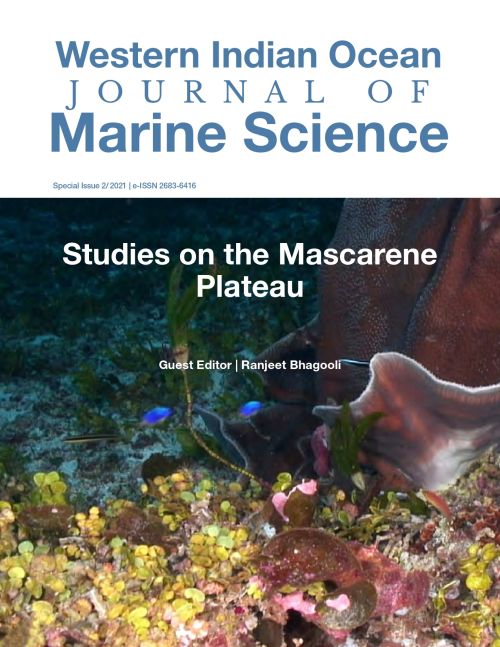Main Article Content
Photo-physiology of healthy and bleached corals from the Mascarene Plateau
Abstract
This study presents the first report of variable photo-physiology of healthy-looking and bleached corals from the upper mesophotic waters of the Mascarene Plateau. In May 2018, during the FAO EAF-Nansen research expedition cruise, coral bleaching was visually observed. Five coral species from Saya de Malha Bank, namely Heliopora coerulea, Favites sp. and Porites sp. from 27 m and Acropora sp. and Lithophyllon repanda from 30 m, and three coral species from the Nazareth Bank, namely Acropora sp. and Galaxea fascicularis from 36 m and Stylophora-like species from 58 m were studied using the Video-Assisted Multi-Sampler (VAMS) and collected using a Van Veen grab. Chlorophyll a fluorescence parameters such as effective quantum yield at photosystem II (ΦPSII), relative maximum electron transport rate (rETRm), photosynthetic efficiency (α), photoinhibition (β), saturating light level (Ek), and maximum non-photochemical quenching (NPQm) were measured using a Diving-Pulse-Amplitude-Modulated (D-PAM) fluorometer to study variable photo-physiology in bleached and non-bleached corals. All photo-physiological parameters varied significantly among coral species tested and between coral conditions, except for β. The interaction between species and coral conditions was only significant in the case of β, but generally not significant. A two-way ANOVA indicated significant effects of depth and coral conditions in Acropora sp. on almost all photo-physiological parameters, except for β, and the effect of depth on rETRmax and α, and the effect of depth along with its interaction with coral conditions on Ek. ΦPSII did not differ in bleached and healthy-looking coral parts of Porites and Lithophyllon from 27 m, Galaxea and Acropora from 36 m while it decreased significantly in Heliopora and Favites at 27 m, Acropora from 30 m, and Stylophora-like at 58 m. NPQm did not change for Porites, Acropora (30 m) and Galaxea but it tended to increase for Heliopora, Acropora (36 m), Lithophyllon, Galaxea, and decrease for Favities, Acropora (30 m) and Stylophora-like. The thermally tolerant coral Porites exhibited normal photo-physiology even in bleached conditions while the bleached parts of Favites, Acropora (30 m) and Stylophora-like corals exhibited photo-physiological dysfunctioning. This study revealed that the seven studied corals from the upper mesophotic waters of the Mascarene Plateau are not spared from the bleaching phenomenon and exhibit variable photo-physiology in bleached and non-bleached conditions. Further studies are warranted to thoroughly understand the coral bleaching patterns and severity during summer periods at the Saya de Malha and Nazareth Banks.






